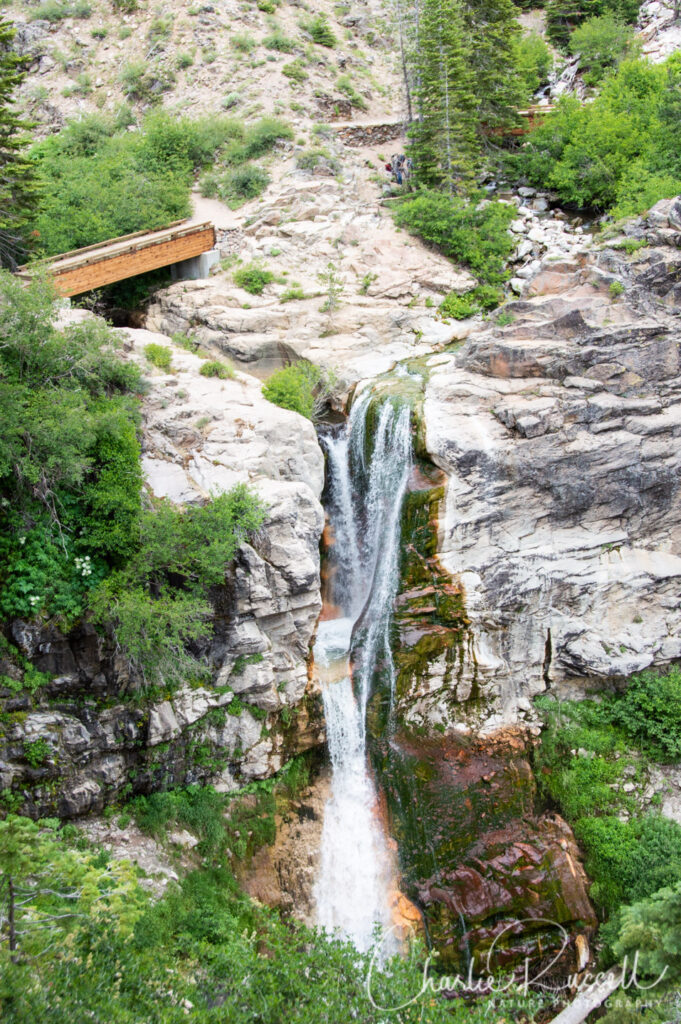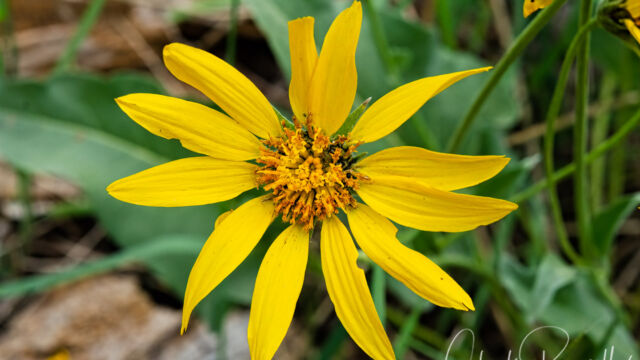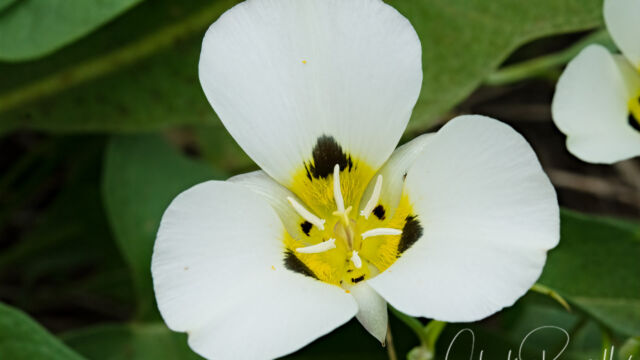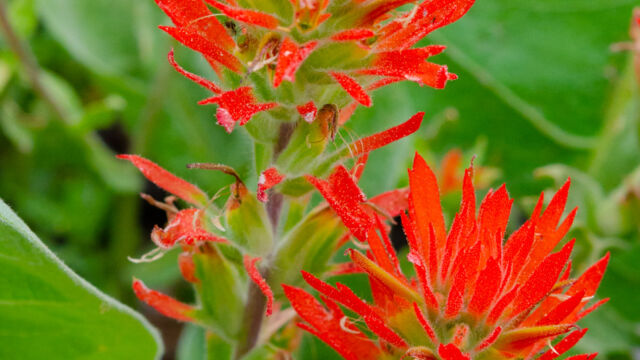The hike to Mill Creek Falls in Lassen Volcanic National Park is interesting because of the variety of plant communities that the trail leads you through. You’ll pass through a red fir forest, traverse open hillside meadows, cross a mountain stream, and end up at a wonderful waterfall. There are wildflowers all along the way.

The Flowers
I love hiking in our national parks like this, far away from areas that are heavily developed. All of the flowers we found here are native California wildflowers, no introduced species like you’ll find in areas closer to towns and agricultural operations.
Here’s a sample of a few of my favorites from this hike (click on the image to see a larger view).
We found quite a bit of California stickseed. This is a beautiful white stickseed, similar in form (but larger) to the more common blue Jessica’s stickseed, which we also found on the trail.


We found Oregon checkerbloom close to the edges of the Mule’s ears meadows, just as you entered the forest.

There were several kinds of penstemon on this hike. A new one for me was Plumas county beardtongue, which we found in the area just past the waterfall.

For the best viewing experience, click on the lightbox image below, and you can scroll through larger versions of the photos of many of the plants (and other things) that we found on this hike. All photos are available for purchase in a variety of formats.
The Hike
This out-and-back hike is roughly 6 miles round trip, with a fair amount of elevation change. It is a popular trail that can have a lot of traffic.
The trailhead is located just east of the Kohm Yah-mah-nee visitor center, near the southwest park entrance. The trail heads downhill from behind the small amphitheater. The start may be a bit confusing as there are several overlapping trails here, including a paved trail that heads south towards a campground. Head downhill through the red fir forest.
After a quick drop down the hill you will come to West Sulphur Creek. You’ll find several species of wildflowers here that you won’t see elsewhere along the trail.
After crossing the creek you will cross several hillside meadows filled with Mule’s ears and Balsamroot. The main bloom was finished when we visited this time, if you get the right timing the view must be amazing.

Just short of 3 miles in you will come to a view point for Mill Creek Falls. I recommend hiking down and just past the falls, as there are flowers there (such as Plumas county beardtongue) that you won’t see elsewhere on the trail.

Here’s the track that we followed:
Mill Creek Falls Trail
Profile
Move your mouse along the elevation graph to show the location on the map. The Refresh icon will re-center the map. The Expand icon will expand to full screen.
Directions
Mount Lassen Volcanic National Park is located east of Redding and Red Bluff in Northern California. This hike starts behind the amphitheater near the Kohm Yah-mah-nee visitor center, which is just past the southwest entrance. There is plenty of parking, and great facilities inside the visitor center.
Timing is Everything
We hiked this trail in early July of a somewhat dry year, and we found a wide variety of native wildflowers all along the trail. You have to pay attention, though, because many of them are not found in great profusion.
The weather was a bit cool and overcast, which made it a bit difficult to get sharp photographs.
I would like to come back here in mid June sometime, because the hillsides near the beginning are just covered with masses of Mule’s ears and Balsamroot – which were just about finished blooming on our July visit.

Lassen Mill Creek Falls Wildflower Listing
Here’s a listing of the native plants that we found on this visit. The ones listed in color are endemic to California (that is, found only in California).
- Arrowleaf balsamroot (Balsamorhiza sagittata)
- Buckwheat sp. (Eriogonum sp. possibly Eriogonum umbellatum)
- California stickseed (Hackelia californica)
- Changeable phacelia (Phacelia mutabilis)
- Cow parsnip (Heracleum maximum)
- Coyote mint (Monardella odoratissima)
- Dwarf groundsmoke (Gayophytum humile)
- Goosefoot violet (Viola purpurea)
- Jessica’s stickseed (Hackelia micrantha)
- Leichtlin’s mariposa lily (Calochortus leichtlinii)
- Meadow larkspur (Delphinium nuttallianum)
- Mountain pride (Penstemon newberryi)
- Naked buckwheat (Eriogonum nudum)
- Oregon checkerbloom (Sidalcea oregana ssp. spicata)
- Pacific bleeding heart (Dicentra formosa)
- Pearly everlasting (Anaphalis margaritacea)
- Plumas county beardtongue (Penstemon neotericus)
- Rose meadowsweet (Spiraea splendens)
- Rough hedgenettle (Stachys rigida)
- Sanddune wallflower (Erysimum capitatum var. capitatum)
- Seep Monkey Flower (Erythranthe guttata)
- Short flowered owl’s clover (Orthocarpus cuspidatus ssp. cryptanthus)
- Sierra morning glory (Calystegia malacophylla)
- Sierra onion (Allium campanulatum)
- Spotted coralroot (Corallorhiza maculata)
- Spur lupine (Lupinus arbustus)
- Staining collomia (Collomia tinctoria)
- Tall phacelia (Phacelia procera)
- Torrey’s cryptantha (Cryptantha torreyana)
- Wavy leaved indian paintbrush (Castilleja applegatei ssp. pinetorum)
- Western hawksbeard (Crepis occidentalis)
- White flowered Hawkweed (Hieracium albiflorum)
- White veined wintergreen (Pyrola picta)
- Woolly mule’s ears (Wyethia mollis)




















































Add comment